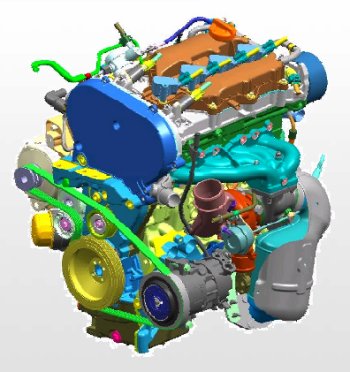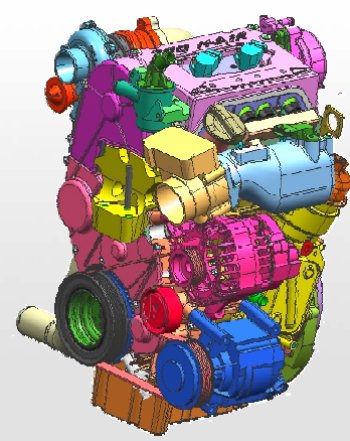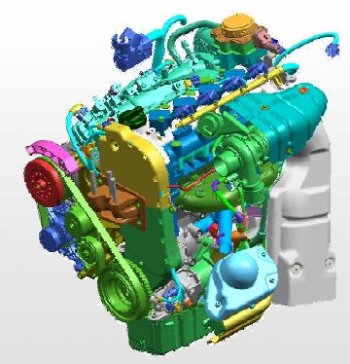|
During the first
day of the investor presentation at Lingotto Fiat confirmed
a raft of new cutting edge engines and technologies
currently under development and scheduled to arrive in
production during the next few years. Highlights include a
brand new compact 0.9 litre Multiair turbocharged petrol
engine and DDCT transmission.
Petrol engines will still prevail in the European medium-low
passenger car segments and offer a number of advantages -
believe Fiat, including robust and low-cost emission control
technology (3-way catalyst) and intrinsic cost advantage
compared to diesel, expected to widen in future. The
technological challenge for petrol engine is to drastically
reduce fuel consumption and improve the fun-to-drive factor,
through: progressive adoption of turbo-charging technology
to improve performance, with emphasis on torque and
driveability; the introduction of breakthrough technology
(Multiair) to significantly reduce fuel consumption through
throttle-less operation; substantial reduction of engine
displacement (downsizing) through synergic integration of
above mentioned technologies and gradual introduction of
direct fuel injection as technology’s cost decreases.
Multiair
Technology on the Fire Engine
The "Multiair" induction technology has been under
development by FPT for some years and will be rolled out
across a range of engines of different capacities and and
characteristics. Using a specially-developed new engine
electro-hydraulic actuator, Multiair will be applied to the
FIRE engine range offering 10 percent higher torque and
power with enhanced dynamic response to pedal; 10 percent
fuel consumption reduction for both turbo and naturally
aspirated units; and a 50 percent emissions reduction. The
technology applicable to Diesels for NOx Emissions
reduction.
New Small
Gasoline Engine (SGE) under Development
One of the most
exciting pieces of news to emerge from the Lingotto
presentation is that a new small capacity, but powerful and
torquey petrol engine is being developed. At just 0.9 litres
in capacity it will be fitted with the new Multiair
induction technology and feature a small turbocharger. This
will add up to a power band ranging from 90 to 110 bhp
depending on application, making this engine as significant
to the development of small, compact, efficient and
responsive petrol engines as the highly-regarded 1.3
Multijet has been to diesels. This new 0.9 litre engine will
offer a fuel economy improvement higher than 20 percent by
its substitution of 1.2 litre naturally aspirated engine on
the A-segment vehicles. The new engine will arrive on the
market in the new Fiat 500 and will also be incorporated into the
next-generation Fiat Panda which is under development.
New Petrol
and Diesel Engines
Fiat also reiterated the imminent arrival the new 1.4 litre
turbo (which will debut on the new C-segment Bravo model)
and which will offer up to 120 bhp, and the new 1.8 litre DI
(direct injection) petrol engine with between 190 bhp and 230 bhp depending on
application.
|
 |
|
Fiat believes dual-Dry-Clutch transmission (DDCT),
combining high comfort and high efficiency at
affordable cost, represents the needed technological
leap forward. |
|
 |
|
 |
|
A new 1.8 DI petrol engine which will offer
between 190 bhp and 230 bhp power depending on
application is being developed by Fiat Powertrain
Technologies. |
|
|
 |
|
One of the most exciting pieces of news to emerge
from the Lingotto presentation is that a new small
capacity, but powerful and torquey petrol engine is
being developed. |
|
 |
|
Fiat also reiterated the imminent arrival the new
1.4 litre turbo (due to debut in the new C-segment
Bravo) which will offer 120 to 120 bhp. |
|
|
Also confirmed was the much rumoured news that a new family
of V6 engines, ranging from 3.0 to 3.5 litres 250-350 bhp
is under development which will make redundant the current
3.2 litre V6 which is derived from a General Motors engine
and which has been criticised.
Transmission Technology Evolution
Transmission technology will evolve in next decade under
pressure of following, presently conflicting, drivers:
increasing customer demand for high-comfort automatic
transmissions and higher transmission efficiency to reduce
fuel consumption; automated manual transmissions (AMT) have
very high efficiency but comfort level still not completely
satisfactory; conventional automatic transmission has
adequate level of comfort but fuel economy penalty will
become increasingly unacceptable; thus Fiat believes
dual-Dry-Clutch transmission (DDCT), combining high comfort
and high efficiency at affordable cost, represents the
needed technological leap forward.
Alternative
Fuels
Natural gas propulsion, reckons the Fiat investor
presentation, is only technically and industrially available
solution for ultra-low emission urban vehicles in the medium
term, while waiting for long-term hydrogen option Natural
gas, biofuels and hydrogen are only alternatives to crude
oil. Fiat Powertrain, presently leader in natural gas
propulsion technologies, aims to further increase its
competitive advantage by extending natural gas
engine/vehicle portfolio (cars-trucks-buses); adding bio
fuel option (tri-fuel versions) to current bi-fuel (natural
gas – gasoline) cars and adopting, natural gas – hydrogen
blends in special urban fleets to promote development of
hydrogen infrastructure
Alternative Propulsion - Hybrids
Hybrid propulsion technology provides consistent fuel
consumption reduction in urban missions, says Fiat, but with
very high add-on cost Fiat Powertrain considers Diesel
hybrid propulsion promising for urban light commercial
vehicles and buses, and is currently developing the
technology for the Daily and Ducato platforms.
|
|
|
|